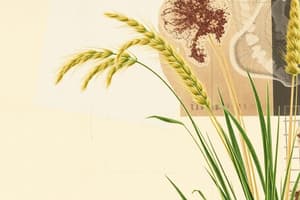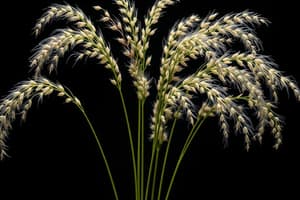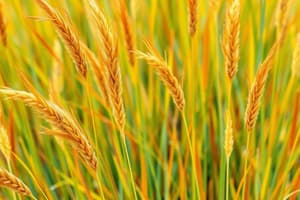Podcast
Questions and Answers
Which plant family does Eragrostis tef belong to?
Which plant family does Eragrostis tef belong to?
- Fabaceae
- Lamiaceae
- Poaceae (correct)
- Asteraceae
What type of plant is Eragrostis tef?
What type of plant is Eragrostis tef?
- Woody perennial
- Woody biennial
- Herbaceous annual (correct)
- Shrub perennial
Where was Eragrostis tef first domesticated?
Where was Eragrostis tef first domesticated?
- India
- China
- Egypt
- Ethiopia (correct)
What part of the Eragrostis tef plant is primarily utilized for food?
What part of the Eragrostis tef plant is primarily utilized for food?
How is Eragrostis tef typically processed for utilization?
How is Eragrostis tef typically processed for utilization?
What characteristics define arugula as an herbaceous plant?
What characteristics define arugula as an herbaceous plant?
In which regions is arugula native?
In which regions is arugula native?
Which step comes directly after the mechanical harvesting of arugula?
Which step comes directly after the mechanical harvesting of arugula?
What is primarily utilized from the arugula plant for culinary purposes?
What is primarily utilized from the arugula plant for culinary purposes?
What process is important to maintain the freshness of packaged arugula?
What process is important to maintain the freshness of packaged arugula?
What is the primary purpose of plant classification?
What is the primary purpose of plant classification?
Which classification system was developed due to problems with common names?
Which classification system was developed due to problems with common names?
How did Theophrastus contribute to plant classification?
How did Theophrastus contribute to plant classification?
What differentiates the genus from the species in a binomial name?
What differentiates the genus from the species in a binomial name?
What major advancement in plant classification occurred during The Age of Herbals?
What major advancement in plant classification occurred during The Age of Herbals?
What is a primary advantage of agriculture?
What is a primary advantage of agriculture?
In which regions was agriculture commonly practiced approximately 5,000 to 7,000 years ago?
In which regions was agriculture commonly practiced approximately 5,000 to 7,000 years ago?
According to Gordon Childe, what initiated the shift from hunter-gatherer to agricultural societies?
According to Gordon Childe, what initiated the shift from hunter-gatherer to agricultural societies?
What was proposed by Carl Sauer regarding the development of agricultural societies?
What was proposed by Carl Sauer regarding the development of agricultural societies?
What was Edgar Anderson's hypothesis regarding plant hybridization?
What was Edgar Anderson's hypothesis regarding plant hybridization?
What does the theory proposed by Binford and Flannery suggest about early plant gatherers?
What does the theory proposed by Binford and Flannery suggest about early plant gatherers?
Which of the following was NOT domesticated in Asia Minor 10,000 years ago?
Which of the following was NOT domesticated in Asia Minor 10,000 years ago?
What development took place around 7,000 years ago in regards to human populations?
What development took place around 7,000 years ago in regards to human populations?
Flashcards are hidden until you start studying
Study Notes
Botanical Information
- Belongs to the Poaceae family, commonly known as the grass family
- Type:
- Herbaceous (no woodiness)
- Herb (not a shrub or tree)
- Annual plant (completes its lifecycle in one year)
- Native distribution primarily in the highlands of Ethiopia and surrounding areas
History as a Food Plant
- First domesticated in Ethiopia around 4000-1000 BCE
- Most widely grown in Ethiopia, particularly in highland regions
Utilization
- The edible part of the plant is the seeds (grains)
- Processing involves grinding the seeds into flour, which is used to make traditional dishes such as injera (a fermented flatbread)
- Seeds can be cooked whole or used in porridge
- Can be fermented to produce alcoholic beverages
- Grown for its nutritional value, rich in protein, calcium, and iron
Botanical Information
- Belongs to the Brassicaceae family, also known as the mustard family.
- Classified as herbaceous due to its non-woody stems.
- Identified as a herb, specifically a leafy green utilized in culinary applications.
- An annual plant, completing its growth cycle in one season.
- Native to the Mediterranean region, encompassing southern Europe, North Africa, and the Middle East.
Utilization
- The edible part of the arugula plant is its leaves, recognized for a peppery, spicy flavor.
- Commonly used in salads, pestos, and as toppings on pizzas, sandwiches, and soups.
- Commercial Harvesting Process:
- Mechanical Harvesting: Utilizes machines to cut leaves at the base while preserving the roots for regrowth; harvested leaves are collected on conveyor belts.
- Sorting and Cleaning: Harvested leaves are sorted to eliminate damaged ones and are thoroughly washed to remove dirt and contaminants.
- Packaging: Cleaned arugula is dried and packaged for wholesale or retail, often using breathable bags or moisture-absorbing packets to ensure freshness.
- Cold Storage: Packaged arugula is kept in cold storage to prolong shelf life before distribution to markets or grocery stores.
History of Plant Classification
- Classification of organisms dates back to Ancient Greek times, driven by the need for ordered systems.
- Key questions in classification: the similarity criteria for grouping and the definition of similarity.
- Early artificial systems grouped plants by appearance or uses rather than evolutionary relationships (e.g., medicinal properties).
- Theophrastus, a student of Aristotle, formulated the first system around 2300 years ago, identifying plant families like Pea and Sunflower.
- The Age of Herbals (1470-1670) popularized herbal manuscripts with illustrations but led to confusion due to varied common names.
- Latin-based nomenclature was developed to standardize plant naming, initially using polynomial nomenclature, which was lengthy.
- Carl Linnaeus introduced the binomial system in Species Plantarum (1753), consisting of a generic name and species epithet (e.g., Picea glauca).
- Nomenclature rules: capitalize the first letter of the genus, italicize the entire name, and use authority designations for naming history.
Plant Species
- The biological species concept defines species as interbreeding groups, but challenges arise in practice (e.g., spatial separation, fertile hybrids).
- Morphological classification focuses on physical characteristics, but plant morphology can be variable due to environmental influences.
- Environmental factors affect morphology: light affects height, moisture influences leaf structure, etc.
- Evolution alters morphological features continuously, leading to diverse adaptations like Rafflesia's large flower and the growth forms of Baobab trees.
Evolutionary Relationships of Flowering Plants
- Phenetic classification emphasizes morphological characteristics, favoring conservative traits over variable ones.
- Charles Darwin's Origin of Species (1859) shifted interest towards phylogenetic classification, emphasizing evolutionary relationships among plants.
- Molecular biology advancements aided in understanding plant phylogenetics, despite challenges posed by the fossil record.
- Two 19th-century theories regarding flowering plant evolution: Englert proposed simple, wind-pollinated flowers, while Hooker hypothesized complex, large flowers with many parts.
- Hooker's model suggests gradual evolution through floral part reduction and sexual plant separation, forming 300-350 recognized flowering plant families.
- Molecular studies have supported the Hooker-Bessey-Cronquist system, confirming its evolutionary relevance.
Flowering Plants: Monocots and Eudicots
- Traditional classification divides flowering plants into monocots (one cotyledon) and eudicots (two cotyledons).
- Monocots are primarily herbaceous with floral parts in multiples of three and a short-lived primary root with a fibrous system.
- Eudicots can be herbaceous or woody, have floral parts in multiples of four or five, and typically develop a taproot from a persistent primary root.
- Genetic studies reveal a third group—magnoliid Angiosperms—evolved before monocots and eudicots.
- Economic importance of magnoliids includes families like Magnoliaceae (Magnolia), Lauraceae (cinnamon, avocado), and Myristicaceae (nutmeg), primarily found in tropical regions.
Overview of Agriculture
- Agriculture involves the intentional cultivation of crop plants, ensuring year-round food availability.
- Developed through the domestication of plants and animals, agriculture transitioned from a hunter-gatherer lifestyle.
- Evidence shows agriculture emerged independently in three global regions around 5,000 to 7,000 years ago.
Domestication of Plants
- The earliest agricultural development traces back to arid regions, especially the Fertile Crescent in Asia Minor (modern Iraq, Iran, eastern Turkey).
- Factors contributing to agriculture's origin in this region include the need for reliable food sources and the native availability of domesticate-friendly wild plants.
Theories of Agricultural Transition
- Childe’s Neolithic Revolution: Proposed that human and herd animal interactions at watering holes resulted in weedy grass species leading to domesticated cereals.
- Sauer’s Favorable Habitats: Suggested sedentary lifestyle development in optimal environments before spreading to less hospitable areas due to population pressures.
- Anderson’s Weed Precursor Theory: Emphasized the role of weeds in genetic variation, promoting plant hybridization in disturbed environments.
- Binford and Flannery's Applied Botany: Proposed that early gatherers used their botanical knowledge for cultivation due to environmental pressures.
Centers of Agricultural Origin
- Asia Minor:
- Wild grain collection dating back 10,000 years; cultivation of wheat and barley began about 8,750 years ago.
- Domestication of goats, sheep, pigs, followed by numerous crops including peas, lentils, grapes, etc.
- Urban civilizations emerged in the Tigris-Euphrates valleys approximately 6,000 years ago with enhanced agriculture techniques.
Geographic Spread of Plants
- Global food plant distributions were originally limited; introduction of new crops transformed agriculture and diets.
- Roman and Arabic expansions introduced significant crops to northern Europe, and European colonialism spread crops like corn and potatoes widely.
- Asian agriculture is notably characterized by the cultivation of rice.
Plant Breeding and Genetic Modification
- The Green Revolution marked a leap in crop breeding, improved soil fertility, pest control, and mechanization.
- Genetic Techniques:
- Genetic Crossing and Back-Crossing: Standard practices for developing new cultivars, highly labor-intensive.
- Chromosome Doubling: Inducing polyploidy through colchicine to enhance plant robustness and yield.
- Genetic Mutation: Can occur naturally or be induced; useful mutations can lead to economically significant crops.
- Genetic Engineering: Involves adding genes from other organisms; faced consumer resistance in Europe and concerns about ecological impacts.
Importance of Genetic Diversity
- Diverse genetic pools are vital for developing new crop varieties and medicinal drugs.
- The ongoing loss of older plant varieties limits future breeding options; older cultivars are increasingly sought for their genetic variation.
- Tropical rainforests contain a large genetic resource base, housing nearly three-quarters of all species on Earth.
Studying That Suits You
Use AI to generate personalized quizzes and flashcards to suit your learning preferences.




